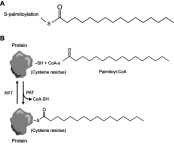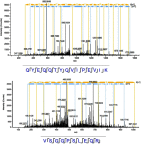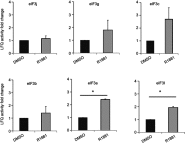Androgen upregulates the palmitoylation of eIF3L in human prostate LNCaP cells
- PMID: 31239713
- PMCID: PMC6556480
- DOI: 10.2147/OTT.S193480
Androgen upregulates the palmitoylation of eIF3L in human prostate LNCaP cells
Abstract
Background: Prostate cancer is the second leading cause of cancer-related deaths in Western countries. Most patients diagnosed with advanced prostate cancer can be treated with the main treatment: androgen deprivation therapy (ADT). The androgen receptor (AR) signaling axis plays a pivotal role in the progression of prostate cancer. However, most patients can ultimately progress to the castration-resistant prostate cancer (CRPC) stage within 2 years. At this stage, drugs targeting the AR signaling axis, including enzalutamide and abiraterone acetate, cannot prevent the progression of prostate cancer, thus predicting a poor prognosis. The molecular mechanism lies in the aberrant AR reactivation, which exhibits an adaptive response to ADT, such as the presence of AR splice variants. Thus, CRPC treatment remains a challenge. Purpose: In addition to the AR axis, a mechanism leading to this progression should be determined. The present study mainly compared palmitoylated proteins between androgen-treated LNCaP cells and non-treated LNCaP cells by palmitoylome profiling, to illustrate the changes at proteomic levels. Materials and methods: To screen the androgen-induced palmitoylated proteins, we conducted proteomic experiments using clickable palmitate probe (Alk-C16) between three individual pairs of androgen-treated and non-treated LNCaP cells. Results: We identified 4351 unique peptides corresponding to 835 proteins, among them a number of these identified proteins were palmitoylated proteins, particularly eIF3L. Androgen treatment significantly increased the palmitoylation level of eIF3L, an individual subunit of eIF3. As an initiation factor, eIF3L plays a pivotal role in the translation of mRNAs encoding growth-promoting proteins by enhancing translation rates, thus controlling cell proliferation. Conclusion: In this study, we demonstrated that the regulation of eIF3L palmitoylation may provide new directions for the therapy of prostate cancer. Moreover, the increased level of androgen-induced eIF3L may be used as a biomarker for the diagnosis of early-stage prostate cancer.
Keywords: androgen; biomarker; eIF3L; palmitoylation; prostate cancer.
Conflict of interest statement
The authors report no conflicts of interest in this work.
Figures







Similar articles
-
Palmitoylome profiling indicates that androgens regulate the palmitoylation of α‑tubulin in prostate cancer‑derived LNCaP cells and supernatants.Oncol Rep. 2019 Dec;42(6):2788-2796. doi: 10.3892/or.2019.7333. Epub 2019 Sep 24. Oncol Rep. 2019. PMID: 31578588
-
Androgen receptors in hormone-dependent and castration-resistant prostate cancer.Pharmacol Ther. 2013 Dec;140(3):223-38. doi: 10.1016/j.pharmthera.2013.07.003. Epub 2013 Jul 13. Pharmacol Ther. 2013. PMID: 23859952 Review.
-
[Palmitoylome profiling indicates that androgens promote the palmitoylation of metabolism-related proteins in prostate cancer-derived LNCaP cells].Beijing Da Xue Xue Bao Yi Xue Ban. 2020 Apr 18;52(2):227-233. doi: 10.19723/j.issn.1671-167X.2020.02.006. Beijing Da Xue Xue Bao Yi Xue Ban. 2020. PMID: 32306003 Free PMC article. Chinese.
-
Role of the Androgen-Androgen Receptor Axis in the Treatment Resistance of Advanced Prostate Cancer: From Androgen-Dependent to Castration Resistant and Further.J UOEH. 2016 Jun 1;38(2):129-38. doi: 10.7888/juoeh.38.129. J UOEH. 2016. PMID: 27302726 Review.
-
Mechanisms of resistance in castration-resistant prostate cancer (CRPC).Transl Androl Urol. 2015 Jun;4(3):365-80. doi: 10.3978/j.issn.2223-4683.2015.05.02. Transl Androl Urol. 2015. PMID: 26814148 Free PMC article. Review.
Cited by
-
Post-Translational Modifications That Drive Prostate Cancer Progression.Biomolecules. 2021 Feb 9;11(2):247. doi: 10.3390/biom11020247. Biomolecules. 2021. PMID: 33572160 Free PMC article. Review.
-
Diverse Roles of Protein Palmitoylation in Cancer Progression, Immunity, Stemness, and Beyond.Cells. 2023 Sep 5;12(18):2209. doi: 10.3390/cells12182209. Cells. 2023. PMID: 37759431 Free PMC article. Review.
-
Quantification of Protein Palmitoylation by Cysteine-SILAC.Methods Mol Biol. 2023;2603:59-69. doi: 10.1007/978-1-0716-2863-8_5. Methods Mol Biol. 2023. PMID: 36370270
-
Targeting eIF3f Suppresses the Growth of Prostate Cancer Cells by Inhibiting Akt Signaling.Onco Targets Ther. 2020 May 4;13:3739-3750. doi: 10.2147/OTT.S244345. eCollection 2020. Onco Targets Ther. 2020. PMID: 32440143 Free PMC article.
-
Advancements in Oncoproteomics Technologies: Treading toward Translation into Clinical Practice.Proteomes. 2023 Jan 10;11(1):2. doi: 10.3390/proteomes11010002. Proteomes. 2023. PMID: 36648960 Free PMC article. Review.
References
-
- Huggins C, Hodges CV. Studies on prostatic cancer: I. The effect of castration, of estrogen and of androgen injection on serum phosphatases in metastatic carcinoma of the prostate. 1941. J Urol. 2002;168(1):9–12. - PubMed
LinkOut - more resources
Full Text Sources
Research Materials

